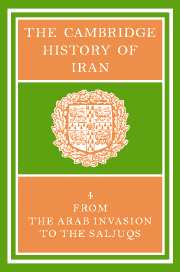Book contents
- Frontmatter
- 1 THE ARAB CONQUEST OF IRAN AND ITS AFTERMATH
- 2 THE ‘ABBĀSID CALIPHATE IN IRAN
- 3 THE ṬĀHIRIDS AND ṢAFFĀRIDS
- 4 The SĀMĀNIDS
- 5 THE EARLY GHAZNAVIDS
- 6 THE MINOR DYNASTIES OF NORTHERN IRAN
- 7 IRAN UNDER THE BŪYIDS
- 8 TRIBES, CITIES AND SOCIAL ORGANIZATION
- 9 THE VISUAL ARTS
- 10 NUMISMATICS
- 11 THE EXACT SCIENCES
- 12 LIFE SCIENCES, ALCHEMY AND MEDICINE
- 13(a) PHILOSOPHY AND COSMOLOGY
- (b) SŪFISM
- 14 THE RELIGIOUS SCIENCES
- 15 SECTS AND HERESIES
- 16 NĀSIR-I KHUSRAU AND IRANIAN ISMĀ‘ĪLĪSM
- 17 ZOROASTRIAN LITERATURE AFTER THE MUSLIM CONQUEST
- 18 ARABIC LITERATURE IN IRAN
- 19 THE RISE OF THE NEW PERSIAN LANGUAGE
- 20 (a) THE “RUBĀ'Ī” IN EARLY PERSIAN LITERATURE
- (b) ‘UMAR KHAYYĀM: ASTRONOMER, MATHEMATICIAN AND POET
- Bibliography
- Index
- Plate section
- Plate section">
- Map 1. Iran under the Abbasids">
- References
16 - NĀSIR-I KHUSRAU AND IRANIAN ISMĀ‘ĪLĪSM
Published online by Cambridge University Press: 28 March 2008
- Frontmatter
- 1 THE ARAB CONQUEST OF IRAN AND ITS AFTERMATH
- 2 THE ‘ABBĀSID CALIPHATE IN IRAN
- 3 THE ṬĀHIRIDS AND ṢAFFĀRIDS
- 4 The SĀMĀNIDS
- 5 THE EARLY GHAZNAVIDS
- 6 THE MINOR DYNASTIES OF NORTHERN IRAN
- 7 IRAN UNDER THE BŪYIDS
- 8 TRIBES, CITIES AND SOCIAL ORGANIZATION
- 9 THE VISUAL ARTS
- 10 NUMISMATICS
- 11 THE EXACT SCIENCES
- 12 LIFE SCIENCES, ALCHEMY AND MEDICINE
- 13(a) PHILOSOPHY AND COSMOLOGY
- (b) SŪFISM
- 14 THE RELIGIOUS SCIENCES
- 15 SECTS AND HERESIES
- 16 NĀSIR-I KHUSRAU AND IRANIAN ISMĀ‘ĪLĪSM
- 17 ZOROASTRIAN LITERATURE AFTER THE MUSLIM CONQUEST
- 18 ARABIC LITERATURE IN IRAN
- 19 THE RISE OF THE NEW PERSIAN LANGUAGE
- 20 (a) THE “RUBĀ'Ī” IN EARLY PERSIAN LITERATURE
- (b) ‘UMAR KHAYYĀM: ASTRONOMER, MATHEMATICIAN AND POET
- Bibliography
- Index
- Plate section
- Plate section">
- Map 1. Iran under the Abbasids">
- References
Summary
PERIODS OF ISMĀ‘ĪLĪSM
In order to appreciate the importance of Nāsir-i Khusrau in the history of Iranian thought, it is necessary to place him in the setting of Ismā‘īlīsm as a whole, for he was one of its most outstanding personalities. Ismā‘īlīsm existed, indeed, outside the world of Iran and the monuments of Ismā‘īlīsm thought produced by Iranians are not all in the Persian language. In the history of philosophy the works of Nāsir-i Khusrau present the interesting feature of being written entirely in Persian, and it is important to recall in the first place to what extent the Ismā‘īlīsm religion influenced the spiritual destiny of Iran and what has survived of its literature in Persian. For this purpose a summary description is required of the different periods of Ismā‘īlīsm.
The Ismā‘īlī religion, it is well known, is a branch of Shī‘ism. It has been designated by several names, sometimes being identified with the Qarmatīs, sometimes referred to simply as the party of the “heretics” (malāhida). There are more precise denominations, for example Sab‘iyya or “Seveners”, an allusion to the heptadic pattern which the Ismā‘īlī discerns in all the planes of existence. The succession of seven imāms or of heptads of imams is merely the expression of it in the plane of hierohistory and this is one of the points which distinguish the Ismā‘īlī doctrine from Twelver Shī‘ism, since the latter recognizes a succession of twelve imāms, but without a recurrence of the cycle. There is the more general designation of Bātiniyya, literally and strictly “Esoterics”, and finally there are the names which the Ismā‘īlīs give to themselves, such as Ahl-i bātin (Esoterics), Ahl-i ta'wīl (those who practise the interpretation [Hermeneutics] of symbols), Ahl-i ta‘yīd (those who are assisted by divine inspiration), etc.
Keywords
- Type
- Chapter
- Information
- The Cambridge History of Iran , pp. 520 - 542Publisher: Cambridge University PressPrint publication year: 1975
References
- 4
- Cited by

